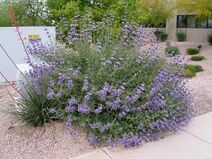Salvia clevelandii
| Salvia clevelandii | |
 | |
| Light: | |
| Moisture: | |
| Hardiness: | 8 |
| Soil pH: | 5.6-8.4 |
| Evergreen | |
| Height: | 2' |
| Native to: | |
| Nectary | |
| Edible Rating: | |
| Tea: | Yes |
Salvia clevelandii (common names: blue sage and Cleveland sage)
A desert native that loves the sun and arid conditions as much as hummingbirds and bees love its blossoms. Fragrant stems of whorled amethyst blossoms bridge Spring and Summer and rise above sprawling silvery-green leaves that make an excellent substitute for sage in cooking. The leaves are evergreen with mature shrubs sheltering ground birds like quail underneath. This perennial was named in honor of plant collector Daniel Cleveland who founded the San Diego Society of Natural History Herbarium.
Propagation: Seed - sow March/April in a greenhouse[1]. Germination usually takes place within 2 weeks. Prick out the seedlings into individual pots when they are large enough to handle and plant them out in early summer. In areas where the plant is towards the limits of its hardiness, it is best to grow the plants on in a greenhouse for their first winter and plant them out in late spring of the following year.
Cuttings of half-ripe wood succeed at almost any time in the growing season[1].
Cultivation: Requires a very well-drained light sandy soil in a sunny position[1]. Prefers a rich soil[2]. Soils rich in nitrogen encourage excessive leaf growth at the expense of flowering[3].
This species is not hardy in the colder areas of the country, it tolerates temperatures down to between -5 and -10°c[1]. Plants can be killed by excessive winter wet[1].
There is at least one named variety. 'Aromas' is an improved selection that is very fragrant[4].
Members of this genus are rarely if ever troubled by browsing deer[5].
Range: South-western N. America - California.
Habitat: Sunny positions in chapparal plant communities[6].
Edibility: The leaves have a pleasant flavour and fragrance, they are a good substitute for sage in cooking[4],
Pollinators: Bees
Soil: Can grow in light and medium soils.
Drainage: Prefers well drained soil.
In Leaf: Evergreen
Flower Type: Hermaphrodite
Links
References
- ↑ 1.0 1.1 1.2 1.3 1.4 Huxley, Anthony. The New Royal Horticultural Society Dictionary of Gardening. MacMillan Press, 1992.
- ↑ Chittendon, Fred. RHS Dictionary of Plants. Oxford University Press, 1951.
- ↑ Bean, William. Trees and Shrubs Hardy in Great Britain. Murray, 1981.
- ↑ 4.0 4.1 Facciola, Stephen. Cornucopia - A Source Book of Edible Plants. Kampong Publications, 1990.
- ↑ Thomas, Graham. Perennial Garden Plants. J. M. Dent & Sons, 1990.
- ↑ Flora of California.